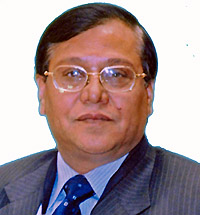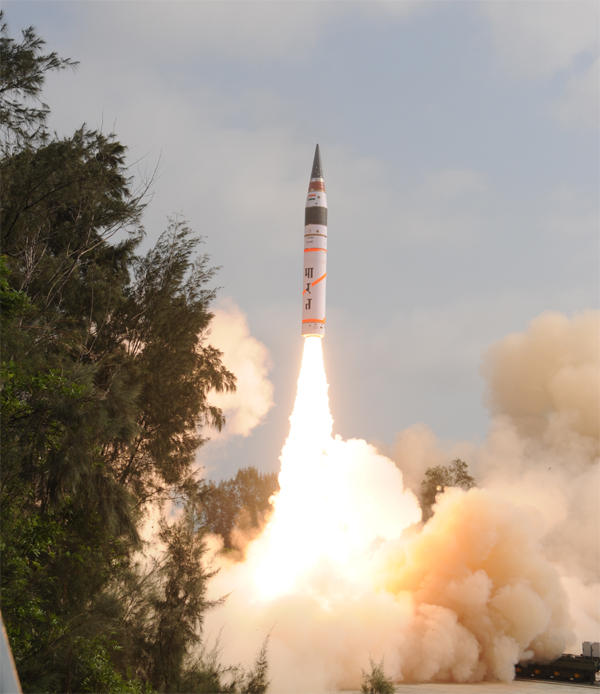|
And with that, India has also gained entry into
the exclusive ICBM club of the US, Russia, France,
Britain and China, becoming the sixth country
in the world with this capability.
The nuclear-capable missile was fired from a
rail-mobile launcher with a dummy one-tonne explosive
warhead which hit the target area deep in the
Indian Ocean, the Ministry of Defence announced.
The three-stage, 50-tonne solid-fuel missile followed
the designated trajectory and was monitored by
Indian naval ships and satellites all through
its approximately 20-minute flight.
Agni-V rose to 600 km in space before descending
and adopting a correct ballistic path, at the
correct designated angle, at a velocity of 6000
meters/ second. The cone of the missile, which
carried the dummy explosive, withstood the high
temperature of about 3,000 degree Celcius upon
re-entry. By then, all the three solid fuel rocket
motors had been used and separated.
Nuclear Triad
India has a declared policy of creating a nuclear
triad for deterrence. At present, some aircraft
of the Indian Air Force (IAF) like the Jaguars,
Mirage 2000s and SU 30 MKIs may have been modified.
The successful development and induction of several
missiles, some of them with the Indian Army, have
given this requirement a decisive edge.
| DRDO’s
Official Statement on the Agni-V Test:
India launches new generation strategic
missile AGNI 5 |
|
New Delhi, Apr 19. The Nation's
dream has become a reality on 19th
April 2012. India’s long range
Missile with a range of more than
5000 kms AGNI-V was successfully test
fired at 08:07 hrs from the Wheeler’s
Island, Odisha.
The flawless Auto Launch of the Missile
started at 08:04 hrs and it took off
from the launch pad at Wheeler’s
Island at 08:07 hrs and started rising
exactly the way it was designed for.
It followed the entire trajectory
like in textbook with the three stages
of Propulsion dropping and falling
at appropriate times into Bay of Bengal.
The three propulsion stages, developed
completely indigenously by DRDO, performed
exactly the way they are intended
to. The indigenously developed Composite
Rocket Motors have performed well
and made India completely self-reliant.
The Ships located in midrange and
at the target point have tracked the
Vehicle and witnessed the final event.
All the radars and electro-optical
systems along the path monitored all
the parameters of the Missile and
displayed in real time.
Lot of new technologies developed
indigenously were successfully tested
in this A5 Mission. The redundant
Navigation systems, very high accuracy
Ring Laser Gyro based Inertial Navigation
System (RINS) and the most modern
and accurate Micro Navigation System
(MINS) ensured the Missile reach the
target point within few meters of
accuracy. The high speed onboard computer
and fault tolerant software along
with robust and reliable bus guided
the Missile flawlessly.
Prime Minister Dr Manmohan Singh
spoke to Dr V.K. Saraswat, the Scientific
Advisor to Raksha Mantri and Mr Avinash
Chander, the Programme Director and
congratulated all the Scientists of
DRDO and said that “DRDO Scientists
have made the country proud.”
Defence Minister A.K. Antony was
monitoring the launch activities and
immediately after successful flight,
congratulated all the Scientists on
this important event.
National Security Advisor (NSA) Shiv
Shankar Menon congratulated DRDO Scientists
and said that the event is a milestone
in the long range Missile era of India.
Air Marshal K.J. Mathews, C-in-C SFC
who witnessed the launch said that
the success of AGNI-V is historical
event for India. Dr V.G. Sekaran,
Director ASL, Dr S.K. Chaudhari, Director
RCI, Mr A.K. Chakrabarti, Director
DRDL, Mr S.P. Dash, Director ITR,
Mr Guruprasad, Director R&DE Engineers
Pune were present during the launch
operations.
Mr R.K. Gupta, Project Director,
guided the team of Scientists and
employees of DRDO during the launch
activities.
|
|
But the third and final leg of this triad will
be complete only next year when the Indian Navy
deploys the indigenous nuclear propelled and nuclear
armed SSBN category INS Arihant submarine.
DRDO is working on submarine-launched ballistic
nuclear missiles, and indications are that some
tests are likely in the coming months.
Range
Although the range of the missile was restricted
to around 5,000-plus km by the Government’s
mandate, sources said that it could be extended
to about 8,000km easily.
MIRV Capability
The missile was officially described as also
an MIRV (Multiple Independently targetable Re-entry
Vehicle) with a capacity to carry 5 or 10 nuclear
warheads of up to 1.5 tonnes weight (total) which
could be delivered during the flight at different
intervals and targets.
It was not disclosed though if the MIRV capability
was demonstrated in the maiden test.
The missile was fired from the Wheeler island
in Odisha (formerly Orissa) on India’s eastern
seaboard in the Bay of Bengal.
High definition cameras on board the ships recorded
the impact and the fireball of explosion with
water rising high in the air. Commercial shipping
was advised to keep off the area as per the standard
operating procedures applicable internationally.
Congratulations
Vice President Hamid Ansari, Prime Minister Dr
Manmohan Singh, Defence Minister A K Antony and
National Security Adviser Shivshanker Menon congratulated
the scientists of the Defence Research and Development
Organisation (DRDO) which has spearheaded India’s
nuclear deterrence capability as part of the country’s
declared No-First-Use-but-Massive-Retaliation
(NFU-MR) policy.
DRDO Director V K Saraswat described the successful
test as “a game changer” while project
in-charge, Dr Avinash Chander, said that Agni-V
was a quantum jump in technology and India would
have “true nuclear deterrence” for the
first time. DRDO has been mandated to develop
and operationalise missiles of various ranges,
and during the last four years, it has spearheaded
and demonstrated a series of missile successes.
Technological Achievements
Significantly, most of the systems on board,
the command centre, propulsion, navigation, advanced
materials and guidance software are indigenous.
That is a landmark achievement.
 Dr
Saraswat also said that all parameters from the
ab initio stage for preparation to the Auto Launch
beginning at 0807h (Indian Standard Time), the
pre-planned flight trajectory and the terminal
impact were textbook proven. Dr
Saraswat also said that all parameters from the
ab initio stage for preparation to the Auto Launch
beginning at 0807h (Indian Standard Time), the
pre-planned flight trajectory and the terminal
impact were textbook proven.
The 50 tonne, 17 meter long Agni 5 had three
stage motors, and according to Dr Saraswat, each
stage separated as programmed. A DRDO statement
issued by spokesperson Dr Ravi Gupta said: “The
three propulsion stages, developed completely
indigenously by DRDO, performed exactly the way
they are intended to. The indigenously developed
Composite Rocket Motors have performed well and
made India completely self-reliant.”
A good thing about the missile is that it is
kept, transported, and fired from a single canister.
It is rail and road mobile, and can be deployed
from anywhere in India.
India already has BrahMos, a supersonic non-nuclear
missile, and some other systems capable of being
stored, moved and fired from their canisters made
from special steels.
Command & Control
India’s NSA as well as the Chairman of the
Chiefs of Staff Committee play a decisive role
in ordering nuclear strikes if ever needed. The
deployment of nuclear weapons though is controlled
by the head of the Strategic Forces Command (SFC),
a three star officer from one of the Services.
Air Marshal K J Mathews, the present SFC Commander
in Chief was at hand to witness the test firing.
He described the success of the Agni-V as “historical”
for India.
Induction
Authoritative sources told India Strategic that
there will be two or three more tests within 2012
and 2013 and that Agni-V should be operationally
inducted by 2014.
The Agni-V is on the cusp of being an IRBM, which
has a range from 3000 to 5,500km, and an ICBM.
Its range can be extended but India has no requirement
to do that. There are no threat perceptions from
countries that far. “Some fine-tuning though
will be there,” they said.
Dr Saraswat chose to describe it simply as a
Long Range Missile.
India has successfully developed and inducted
missiles of various ranges, from short to 3,500km
Intermediate Range Ballistic Missile (IRBM) already.
Anti Satellite Capability
Can the Agni-V missile be turned into an anti-satellite
rocket?
DRDO sources said that this capability already
exists with India although the Agni-V would enhance
this. But there was no direction from the Government
to develop anti-satellite weapons as a matter
of policy. India does not want A-SATs (Anti-Satellite
weapons).
Target Countries
Notably, India’s nuclear-tipped missiles
are targeted at present to cover the whole of
Pakistan and parts of China, the only two countries
from where there is a nuclear threat to India.
With Agni-V, the whole of China is covered.
Also, nuclear missiles do not need to be precision
weapons. A nuclear bomb is used as an area weapon,
and causes the same destruction irrespective of
where it impacts.
But the best use of the nuclear weapons is for
deterrence, as has been the case after World War
II despite the long Cold War that continued between
the US-led western countries and Soviet-led eastern
block countries.
That is what India desires and hopes to achieve.

|